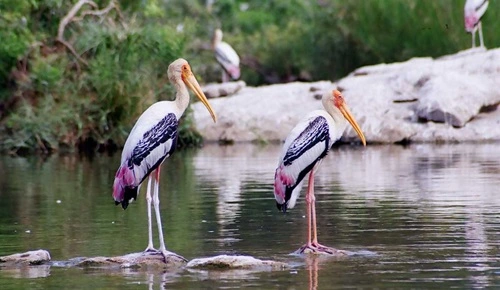Ranganathittu Bird Sanctuary, located near Srirangapatna in Karnataka, is a remarkable destination for nature lovers, birdwatchers, and wildlife photographers. Spanning over 40 acres, this sanctuary comprises six small islets on the Kaveri River, providing an ideal habitat for diverse bird species. Known as the largest bird sanctuary in Karnataka, Ranganathittu is a true paradise where visitors can witness a rich variety of migratory and resident birds in their natural habitat. Planning your visit during the right season will allow you to make the most of this beautiful sanctuary, where each time of year offers distinct experiences.

Best Seasons to Visit Ranganathittu Bird Sanctuary
1. Winter (November to February)
Winter is considered the best time to visit Ranganathittu Bird Sanctuary, as it coincides with the migratory season when the sanctuary sees an influx of birds from different parts of the world. The temperature during winter ranges from 15°C to 25°C, making it a comfortable and pleasant season for outdoor exploration and birdwatching.
This season is ideal for witnessing migratory birds such as Painted Storks, Black-headed Ibis, Spoonbills, and the striking Eurasian Spoonbill. The river is dotted with these magnificent birds, and the islets provide perfect nesting spots. The sanctuary’s wetlands become a breeding ground, creating an ideal setting for observing the birds’ social interactions, feeding habits, and nesting behaviors.
Winter mornings offer clear, soft light, perfect for photography, allowing photographers to capture stunning shots of the birds against the backdrop of lush greenery and calm waters. Boat safaris, which take visitors close to the bird colonies, offer a fantastic opportunity to see these birds up close. As winter is a peak season, it’s advisable to visit early in the morning or later in the afternoon to avoid crowds and catch the birds at their most active.
2. Spring (March to May)
Spring in Ranganathittu Bird Sanctuary brings warmer weather, with temperatures ranging from 20°C to 35°C. Although the days can get warm, the mornings and evenings remain pleasant, and this season is excellent for observing the young fledglings as they take their first flights and learn essential survival skills.
During spring, the migratory birds begin their journey back, but many still remain, including various stork species and pelicans. Resident birds, such as the Indian Cormorant, Black-crowned Night Heron, and Little Egret, are active during this season, making it a great time for birdwatchers to spot both migratory and resident species together.
The sanctuary is less crowded in spring compared to winter, allowing visitors a more peaceful experience. Early mornings and late afternoons provide the best conditions for birdwatching, as the birds are most active during these times. Carrying water and sun protection is advisable, as the afternoons can get quite warm.
3. Monsoon (June to September)
Monsoon brings abundant rainfall to Ranganathittu Bird Sanctuary, revitalizing the greenery and creating a fresh and vibrant environment. Temperatures during this season range from 20°C to 28°C, and while heavy rains can make travel challenging, the lush landscapes and the blooming flora make the sanctuary look stunning.
Monsoon is a breeding season for many resident birds, so visitors can see various species building nests, caring for eggs, and feeding their young. Species like the Indian Shag, Darter, and Grey Heron are often observed engaging in these activities. For photographers, the rain-washed foliage and misty atmosphere create a unique backdrop, adding a dramatic touch to bird photographs.
Boat safaris continue during the monsoon, though they may be paused temporarily during heavy rains. If you’re willing to brave the rains, monsoon offers a quieter, more intimate experience with nature. However, be prepared with rain gear and waterproof clothing to ensure a comfortable visit.
4. Autumn (October)
Autumn marks the beginning of the migratory season as winter approaches, bringing the first wave of migratory birds to Ranganathittu. The weather is cool and pleasant, with temperatures around 20°C to 30°C. Visiting in October provides a chance to witness early migratory birds arriving and settling into their nesting areas.
October is an excellent time to visit for those who want to avoid the peak winter crowds but still experience the arrival of the migratory season. This month also allows you to enjoy both the beauty of the fresh post-monsoon greenery and the start of the migratory influx, giving a preview of the sanctuary’s winter splendor.
Practical Tips for Visiting Ranganathittu Bird Sanctuary
- Timing: The sanctuary is open from early morning until evening, with morning hours providing the best light for photography and bird activity. Visiting during these hours also avoids the midday heat in warmer seasons.
- Boat Safari: The boat safari is a must-do experience, allowing visitors to get close to the birds and observe them without disturbing their habitat. Boats are operated by trained guides who provide information about the bird species and their behaviors.
- Binoculars and Camera: Bring a good pair of binoculars for detailed birdwatching and a camera with a telephoto lens for photography. This will enable you to capture detailed images of the birds from a distance.
- Clothing and Footwear: Light and breathable clothing is recommended for warmer months, along with comfortable footwear suitable for walking around the sanctuary. In monsoon, carry waterproof clothing and avoid slippery shoes.
- Environment Conservation: Visitors are encouraged to respect the sanctuary’s environment by not littering, refraining from disturbing the wildlife, and maintaining silence to avoid scaring the birds.
Conclusion
Ranganathittu Bird Sanctuary offers an unparalleled experience for bird lovers and nature enthusiasts. From the bustling migratory season of winter to the lush, peaceful ambiance of monsoon, each season offers a distinct perspective of this bird haven. Planning your visit based on your preferred birdwatching season or photography conditions will enhance your time at Ranganathittu. So pack your binoculars, set out on a tranquil boat ride, and let the serene beauty of Ranganathittu Bird Sanctuary captivate your senses and leave you with memories of Karnataka’s incredible avian diversity.


